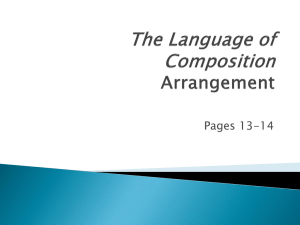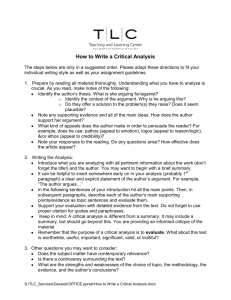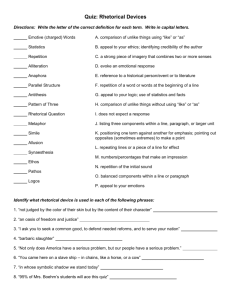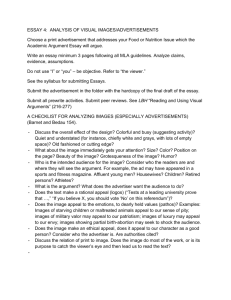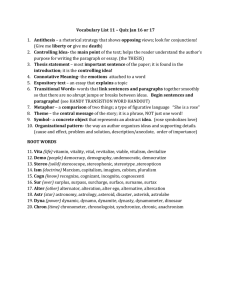DC English IV Student Learning Objectives
advertisement
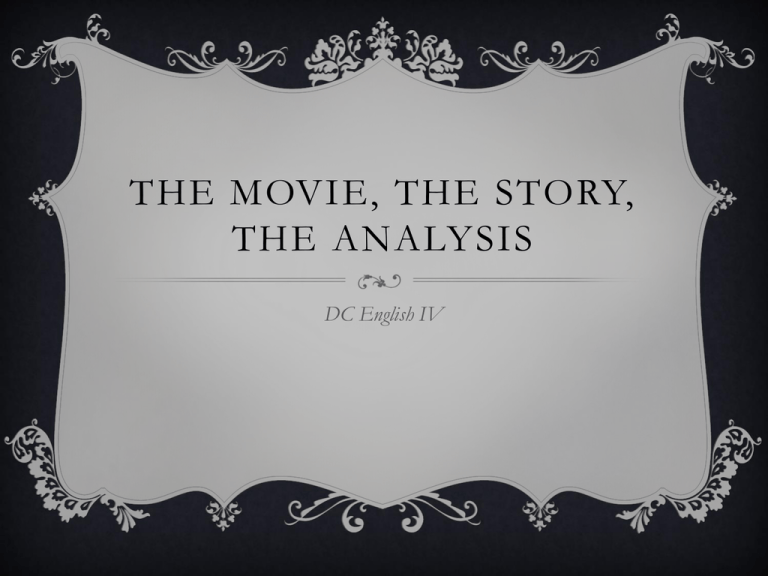
THE MOVIE, THE STORY, THE ANALYSIS DC English IV STUDENT LEARNING OBJECTIVES This assignment can teach students to • Emphasize invention as part of the writing process • Read critically • Analyze the language of a text • Use textual evidence to support ideas • Sharpen their receptivity to language, heightening their own writing style • Become more accepting and appreciative of complexity, subtlety, and ambiguity in literature and in other forms of art and discourse • Practice writing and organizing an essay around a central thesis • Gain insight into the ways writers use language and readers interpret meaning from it • Write to influence readers and shape their opinions • Reflect metacognitively on what they have learned A “Short” Story “FOR SALE: BABY SHOES, NEVER WORN.” RHETORICAL ANALYSIS Rhetoric is the study of how writers and speakers use words to influence an audience. A rhetorical analysis is an essay that breaks a work of non-fiction into parts and then explains how the parts work together to create a certain effect—whether to persuade, entertain or inform. You can also conduct a rhetorical analysis of a primarily visual argument such as a cartoon or advertisement, or an oral performance such as a speech. APPEALS An appeal is an attempt to earn audience approval or agreement by playing to natural human tendencies or common experience. There are three kinds of appeals: the pathetic, the ethical, and the logical. PATHOS The pathetic appeal invokes the audience’s emotion to gain acceptance and approval for the ideas expressed. (Note that in this context, the word “pathetic” has none of the negative connotations associated with it in other contexts but refers only to the ability to stir emotions.) In a pathetic appeal, rhetoricians tap a reader’s sympathy and compassion, anger and disappointment, desire for love, or sadness to convince the audience of their argument. Effective rhetoricians can create these feelings in an audience even if the feeling wasn’t there before. • Ex. TV commercials asking viewers to sponsor a third world child appeal to the viewer’s compassion and instinct to protect the innocent. ETHOS The ethical appeal uses the writer’s own credibility and character to make a case and gain approval. Rhetoricians use themselves and their position as an “expert” or as a “good person” to give their argument presence and importance. An everyday example of this is a minister, rabbi, priest, or shaman—individuals who are followed because they have established themselves as moral authorities. Writers using ethos may offer a definition for an obscure term or detailed statistics to establish their authority and knowledge. LOGOS The logical appeal uses reason to make a case. Academic discourse is mostly logos-driven because academic audiences respect scholarship and evidence. Rhetoricians using logos rely on evidence and proof, whether the proof is hard data or careful reasoning. • Ex.1 In his Divine Watchmaker argument, William Paley employs logical comparison to prove that something as complex as life and our world could not have occurred by chance. • Ex.2 Toothpaste commercials like to appeal to logos by citing statistics and using scientific language to describe the process of preventing cavities. R E M E M B E R T H A T A S I N G L E D O C U M E N T, SPEECH, OR ADVERTISEMENT CAN M A K E A L L T H RE E A P P E A L S. RHETORICIANS WILL OFTEN COMBINE TECHNIQUES IN ORDER TO CREATE A P E R S UA S I V E A R G U M E N T. ASSIGNMENT (ESSAY #2) You are going to have ONE class period to write a Rhetorical Analysis of Slum Dog Millionaire. Two page MAXIMUM, One and a half page MINIMUM. MLA format You MUST have a works cited page which includes a citation for the movie (which you will discuss/quote) and any other resources you decide to use. (You only have to use the movie, unless you choose otherwise)
